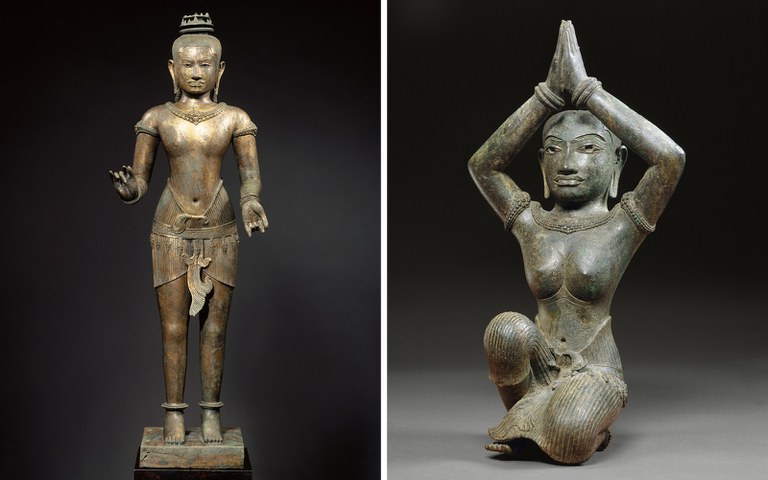Original published: Benarnews Thailand
When an American museum announced last week that it would return two Angkor era statues to Thailand, including the well-known “Golden Boy ” dating to the 11th century, the emotive issue of stolen antiquities became a hot topic here.
Turns out, many Thais discovered that more than 100 stolen artifacts from their country are scattered in museums worldwide, according to experts.
But the Thai government, for now, has formally requested the return of only about 30 items – the repatriation of artifacts is a long process – and even those efforts have so far proven futile, according to noted local archaeologist Thanongsak Hanwong.
“We have officially submitted documents requesting the return of over 30 artifacts to various countries,” Thanongsak, who’s also a member of a government committee for the repatriation of stolen artifacts, told BenarNews.
“Additionally, there are about ten more cases where official requests have yet to be sent. However, Thai embassies abroad are negotiating their return. Some museums are reluctant to publicize these repatriations.”
Last Friday, the Metropolitan Museum of Art in New York announced it was returning the two statues to Thailand along with 14 artifacts – also from the Angkor period – to neighboring Cambodia.
What might explain this wide difference in the number of artifacts being returned to the two countries?
Especially considering that the Met, as the world-famous New York institution is known, also holds notable 9th century Thai statues “Bodhisattva Avalokiteshvara” and “Bodhisattva Maitreya – Thailand has been unsuccessfully trying to recover the former since 2016, Thanongsak said.
A ‘complex’ process
Many museums abroad just ignore Thailand’s return requests despite the artifacts’ provenance established as Thai, said Thanongsak and his group “Sam-nuk Sam-Roi Ong” (SSO), a group of local archaeologists and historians.
What does not help is that the Thai government has never explicitly said it prohibits its antiquities from being sold and taken overseas, Thanongsak said.
Cambodia’s success in repatriating many of its artifacts from abroad is due to its government’s declaration that it never consented to Khmer art leaving the country. Therefore, Khmer artifacts located outside of Cambodia are considered to have been acquired illegally, Thanongsak said.
“Cambodia has clearly stated that they never permitted the export of their artifacts, unlike Thailand, where permissions have been granted at the discretion of the Director-General of the Fine Arts Department,” he said.
“The process of repatriating Thai artifacts is more complex than that of Cambodia, as it requires proof that the items were indeed stolen.”
The Thai government’s Department of Fine Arts is actively pursuing the return of Thai artifacts scattered abroad, Phanom Butrachoti, the department’s director-general, told BenarNews.
“It might seem slow, but each artifact requires careful consideration by relevant committees to ensure its illegal export from Thailand, to avoid future complications,” Phanom said.
Take the case of “Golden Boy,” which the Met’s website describes as an 11th century statue, possibly of the mythical Hindu god Shiva, made of gilt-copper alloy and silver inlay.
“The process to repatriate the ‘Golden Boy’ took over three years of negotiations and gathering information from local villagers,” Thanongsak said.
The statue (pictured above) had been found by locals in Buriram province in the early 1970s. British antiquities dealer Douglas A.J. Latchford bought it from the locals for 1 million baht back then, and sold it abroad.
“The pursuit to reclaim ‘Golden Boy’ started in 2021. I presented this case to the Committee for the Follow-Up on Antiquities. [Was] sent to Ban Yang (in Buriram), I gathered information to substantiate its origins,” the Thai archaeologist said.
“Our efforts, backed by detailed data and Latchford’s book citing its acquisition from Ban Yang, eventually led to the Met’s representatives negotiating with Thailand, resulting in its return.”
The ‘Phra Narai Bantomsin lintel affair’
The Met agreeing to return the statue “is not a common occurrence,” Thanongsak said.
“Another instance of such a return was the Narai Bantomsin lintel,” he said.
He was referring to a stone carving of a façade from between the 12th and 14th centuries, which went missing or was stolen in the 1960s from Phanom Rung Historical Park and later found displayed at The Art Institute of Chicago.
Its return was a result of extensive campaigns and protests by a charged Thai public.
The way it’s told, what came to be called “The Phra Narai Bantomsin lintel affair” took off in February 1988, when Thai newspapers all together published an open letter from the Thai public demanding the lintel be repatriated.
In May that year, more than 500 Thais protested in front of the Art Institute of Chicago, demanding for the return of the lintel.
The same year, Thai rock band “Carabao” released an album called “Narai Bantomsin,” with the cover showing the Statue of Liberty holding the lintel. Included in the album was a song titled “Return Michael Jackson, bring back Narai.”
Pressure was mounting. A Chicago-based philanthropic group, the Elizabeth F. Cheney Foundation, noticed the brouhaha and decided to facilitate the lintel’s return.
The foundation offered the museum in Chicago Thai artifacts worth 50 million baht as a replacement for the stone artifact, and the institute agreed to let go of the lintel.
The stone artifact arrived at Don Mueang Airport on the evening of Nov. 10, 1988, to a media reception of the kind reserved for international rock stars, the Bangkok Post reported.
The arrival event, which was broadcast nationwide, included the opening of the wooden crate that contained the lintel.
When the lid was lifted to reveal the stone carving, the cheer almost rocked the airport.
Narai Bantomsin was finally home.
Shailaja Neelakantan in Washington contributed to this report.
www.facebook.com/tcijthai
Tags






